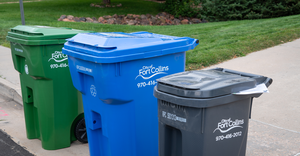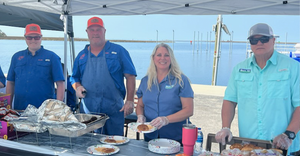Wastewater Treatment Plants Leverage Infrastructure to Drive Down Emissions
Wastewater treatment generates about 20 million metric tons of CO2 equivalent in the U.S. every year. A few water utilities are offsetting some of those emissions by leveraging their existing infrastructure to turn food waste that would otherwise be landfilled into renewable natural gas (RNG).

Wastewater treatment generates about 20 million metric tons of CO2 equivalent in the U.S. every year. A few water utilities are offsetting some of those emissions by leveraging their existing infrastructure to turn food waste that would otherwise be landfilled into renewable natural gas (RNG).
Victor Valley Wastewater Reclamation Authority (VVWRA) is the first facility of its kind in California to go this route. Working with renewable energy company Anaergia, VVWRA is co-digesting postconsumer food waste with the wastewater biosolids that it was processing all along in its anaerobic digesters (AD).
The partnership between the two entities dates back some time before the 2022 launch of this co-digestion project. Nearly 10 years ago, Anaergia began making electricity from methane from the biosolids that VVWRA was digesting. The Authority had been flaring the gas that, with this first project, now provided heat and power to its facility.
Through the newest venture, the end product serves more than VVWRA. Up to 235,000 tons per year of organic waste and wastewater solids are converted to 320,000 million British thermal units (MMBtu) of power that are injected into the Southwest Gas system.
The project cuts greenhouse gases by 72,600 tons a year, offsetting more emissions than the operation creates.
When Anaergia proposed adding food waste to the mix, the Authority had three decommissioned digesters; they’d sat idle for years. And one of the region’s largest natural gas lines ran through its property.
“We had all these resources and Southwest Gas was interested in bringing in RNG, so a lot of important components aligned,” says Darron Poulsen, general manager Victor Valley Wastewater Reclamation Authority.
Anaergia helped bring the three mothballed digesters back online and upgraded them so food waste could be co-digested with the wastewater biosolids. The energy company receives the gas at a facility across the street from where the digesters do their work and cleans it to pipeline quality.
The massive tonnages of food waste produce substantially more gas than the sludge that VVWRA was accustomed to processing, which presented a learning curve.
“With food waste, you have to be mindful of the volatility of the gas you are making. You must maintain a certain pressure, so we have to be careful about what type of material and how much we put into the digester,” Poulsen says.
“But it’s the same process. It does not impact your operations if you do it right. That’s why this is such a great opportunity for wastewater treatment plants,” he says.
VVWRA chose to do this work for three reasons: to create a secondary revenue stream, ultimately gaining better control of wastewater treatment costs. To reduce greenhouse gases.
And at least as incentivizing was that now the Authority could leverage its resources to provide another service to cities –helping them better manage amassing organic trash, which became all the more critical with the passage of SB1383, requiring California municipalities to divert 75% of their organic waste from landfills by 2025.
“If our work with Anaergia helps our member agencies with their diversion that’s a good use of public funds. And we can do it economically on a very large scale,” Poulsen says.
North America’s wastewater treatment plants represent a sizable network of under-utilized infrastructure, paired with a tremendous supply of recoverable resources –wastewater. Having both the material and the equipment presents a real opportunity for utilities to get into the renewable energy production game, says Yaniv Scherson, Anaergia’s chief operating officer.
He believes there’s potential to upgrade thousands of wastewater treatment plants by replicating the Victor Valley model, increasing capacity and generating a lower-carbon product.
“Billions of dollars of existing public infrastructure could be leveraged to provide clean energy, improve air quality, and reduce greenhouse gas emissions to address climate change – all from waste which they’re already treating,” Scherson says.
Paulsen has seen public perception of wastewater plants change a lot in his 37 years in the business.
“When I started it was a service people didn’t appreciate. It was not seen as a resource beyond to take care of a nuisance they didn’t want to deal with,” he reflects.
The mindset began evolving in the early 2000s with heightened attention to water shortages.
“Now wastewater treatment plants were seen as more important and appreciated in the sense that we were producing water that could be recycled.
“As we have grown and technologies have improved people have started to reimagine all the materials that these plants can produce There’s the realization that there is more we can do with regard to methane and biosolids,” Paulsen says.
Today, the material that comes into VVWRA leaves in three different forms: renewable natural gas, fertilizer (a byproduct from AD), and water left after the treatment process that’s recycled for landscaping.
Scherson says this co-digestion model is starting to catch on among other municipal wastewater treatment operations.
Anaergia is currently working on similar projects in the California counties of San Bernardino, Monterey, Riverside, Contra Costa, and San Diego, as well as in New Jersey, Ontario, Canada, and Singapore.
As far as the early work with VVWRA, Toyota Motor North America is expected to use the output for conversion to hydrogen as part of its decarbonization efforts.
About the Author
You May Also Like




